-
Confidence in Spain's leading newspaper brands is recovering, especially in local and regional media.
-
The issue of news ninis is growing: 37% of Spaniards are neither interested in the news nor trust them.
-
Concern persists in Spain about misinformation on the Internet (64%).
The data of the survey of 2023 allows us to affirm that Spaniards continue to distrust news on a regular basis. The percentage of respondents who say they do not trust the information is the highest in the entire historical series of the Digital News Report Spain, with 40% of distrustful. On the other hand, the percentage of people who frequently trust the news seems to have found ground and stagnates at 33% of respondents. Compared to previous years, it can be seen that a significant percentage of the undecided has shifted towards a loss of confidence in the news. The gap between confident and skeptical is the largest since 2015 (7 percentage points).
Looking back, it is possible to establish two very clear phases in the evolution of Spaniards' trust in the news. From 2015 to 2017, trust in the news increased significantly, from 34% in 2015 to 51% in 2017. At the same time, distrust gradually decreased (see graph). This period is characterized by an improvement in the perception of the veracity of news and a higher Degree of trust in general.
However, from 2018 and up to 2023, there is a trend to the leave in trust in news, which falls to levels of 44% in 2018 and 2019. These are the years of the birth of the term "fake news", popularized during Donald Trump's term in office and used in the Spanish public discussion following the illegal referendum on Catalan independence, when numerous accusations of disinformation arose from both the Spanish government and Catalan independence supporters. These are also the years in which the most extreme parties introduce criticism of the media as a regular element of their political diary and in which social, political and informational polarization becomes more acute. In 2020, barely 36% of Spaniards habitually trusted the news, a figure that continued to fall to the current 33%. In the same period of time, the percentage of Spaniards declaring that they did not usually trust the news rose from 30% in 2018 to 40% in 2023, in what is characterized as a lack of recovery of previous trust and greater uncertainty as to the veracity of the news.
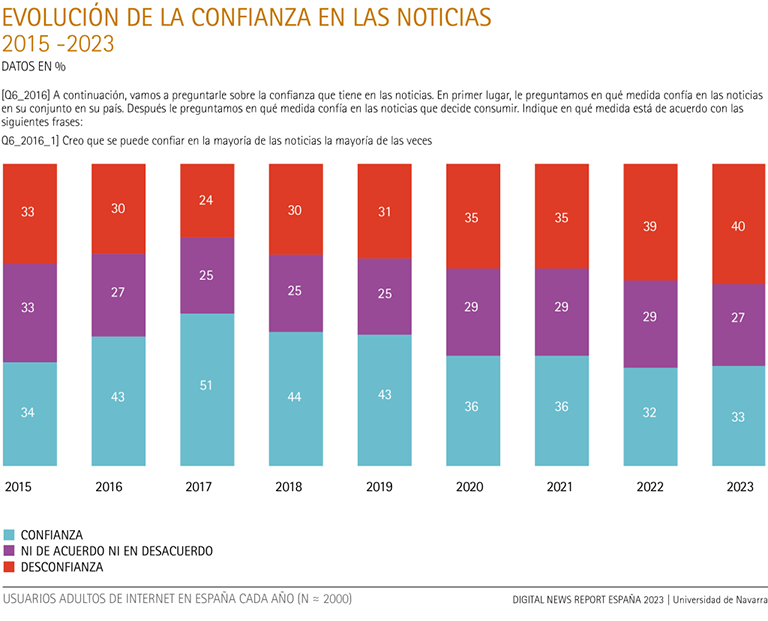
Turning to 2023, the sociodemographic analysis of trust in news sample some new developments. Although the group of the youngest respondents (under 35 years of age) continues to show the lowest levels of trust in contrast to those over 55 years of age (see graph), the lack of trust is spreading among the older cohorts. Specifically, in the group of respondents aged between 35 and 44, the percentage of distrustful respondents has increased by 7 percentage points in the last year, to 44%. As a result, the difference in this group between those who trust and those who distrust has gone from 10 percentage points in 2022 to 17 points in 2023. And one last piece of data illustrating the spread of distrust to more adult groups: of all age groups, only among those over 55 years of age do those who trust the news outnumber skeptics.
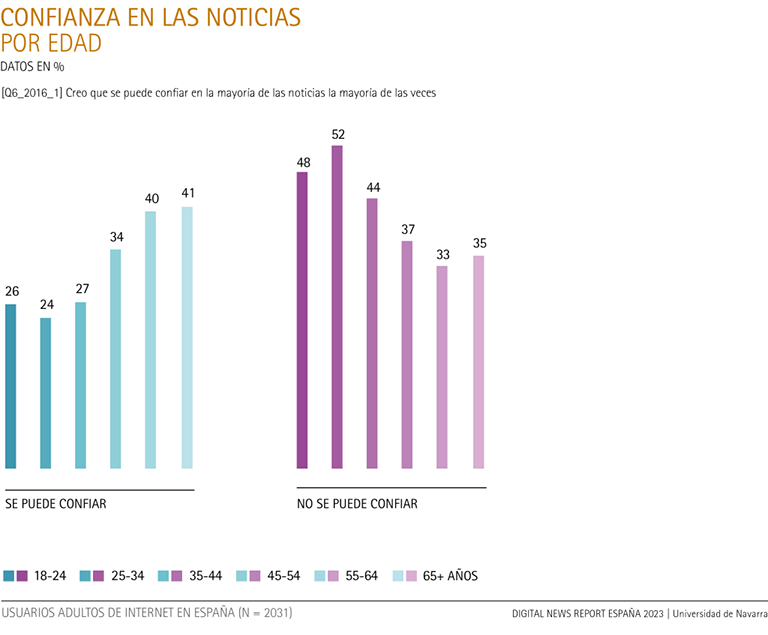
The rest of the sociodemographic factors sample show that there is no clear relationship between income level and trust. On the contrary, the Degree of Education does seem to influence informational trust. The data show that those respondents with a higher training level (middle/higher or with Degree/postgraduate program completed) tend to show lower levels of trust (31%) and higher levels of distrust (46%) compared to those with a lower training level (31% trust and 37% distrust).
Finally, the analysis of trust in the news by political ideology offers an interesting trend: individuals with a left-wing ideology show the lowest percentage of trust (29%), followed by those in the center (37%) and those on the right (35%).
Comparison with other countries
With 33% of users trusting the news, Spain is below the overall average of 40% recorded among all countries. Moreover, the percentage of distrust in news in Spain, at 40%, is one of the highest in Europe, surpassed only by a handful of countries.
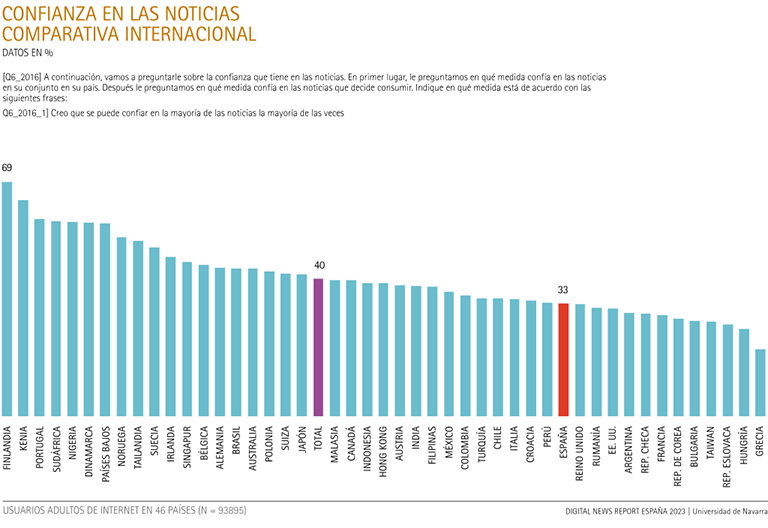
Within the European context, a trend B of lower trust is observed in Southern European nations, with the exception of Portugal (58% trust). The remaining countries such as Italy (34%), Greece (19%) or Spain (33%) seem to be dealing with a higher level of skepticism towards the news compared to their northern and central European neighbors. Thus, Nordic countries exhibit the highest levels of trust in the news, such as Finland (69%) and Denmark (57%). And Central European countries, such as the Netherlands and Germany, also reflect moderate trust in the news, with trust percentages of 57% and 43% respectively.
Beyond Europe, trends in trust in news vary. Countries in Asia, such as Japan and Singapore, show trust percentages of 42% and 45% respectively, indicating moderate trust in the news. In North America, both the United States and Canada show relatively low levels of trust in news, at 32% and 40% respectively. The United Kingdom, on the other hand, has a similar level of trust to Spain, with 33%.
One indicator of Degree of news trust is the so-called "net trust", i.e., the difference between the percentages of respondents who regularly trust the news and those who do not. This measure provides a clearer picture of the balance between those who trust and those who are skeptical of the news in each country.
As can be seen in the graph, among the countries with the highest net trust in the news are Finland (53%), Denmark (44%) and the Netherlands (41%), all European countries. Outside European borders, Kenya also sample a high level of net trust in news (40%), indicating a generalized positive perception of news in this country.

However, this high net trust in news is not universal in Europe. In contrast to the Nordic countries, several southern and central European countries have a net trust in news leave or even negative. This is the case of Spain, which presents a net trust of -7%, which places it among the countries with the lowest net trust in news. This suggests a significant level of skepticism towards news in Spain, shared with other European countries such as France, Hungary, the Slovak Republic, Bulgaria and Greece, all of which have negative net trust.
Outside Europe, trends vary significantly. In Asia, for example, Japan and Singapore show relatively high net trust in the news (27% and 30% respectively), while the Republic of Korea and Taiwan show much higher net trust leave (2% and 10% respectively). In North America, both the United States and Canada also show a net leave trust in the news (-10% and 11% respectively).
The third person effect is intensifying: I do not trust the news in general but I do trust my media.
This year's data suggests that respondents tend to show greater trust in the news they consume compared to news in general. This could be due to a variety of factors, including the possibility that respondents select news sources they consider more trustworthy, or that familiarity with a particular news source may increase perceptions of its trustworthiness. This would result in a third-person effect: people trust their own media (40%) more than the media in general (33%) and distrust their own media (31%) less than the media in general (40%). This was already the case in other years, but in 2023 the difference between trust in the news in general and the news one consumes increases.
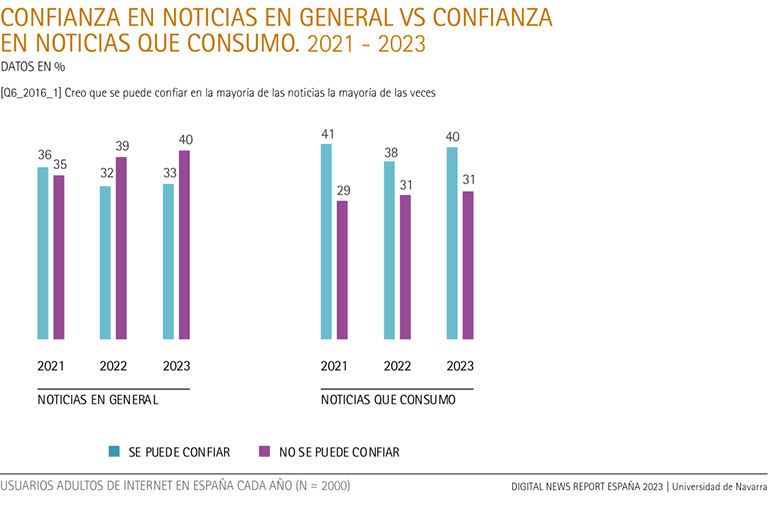
After the decline of 2022, credibility in Spanish journalistic brands recovers
After the sharp drop in trust in the journalistic brands analyzed in 2022, Spaniards have partially recovered their trust in these brands (up 3.9 percentage points from average ).
In general terms, most newspaper brands have experienced an increase in the percentage of users who trust them between 2022 and 2023. Some of the most notable increases are found in COPE (6 percentage points), from 39% in 2022 to 45% in 2023; regional or local newspapers (6 pp), going from 46% in 2022 to 52% in 2023, and Cadena SER and Antena 3, both with an increase of 4.8 and 4.4 points respectively. The only exception is La Sexta, which barely experienced a significant change in the level of confidence, remaining at 42%.
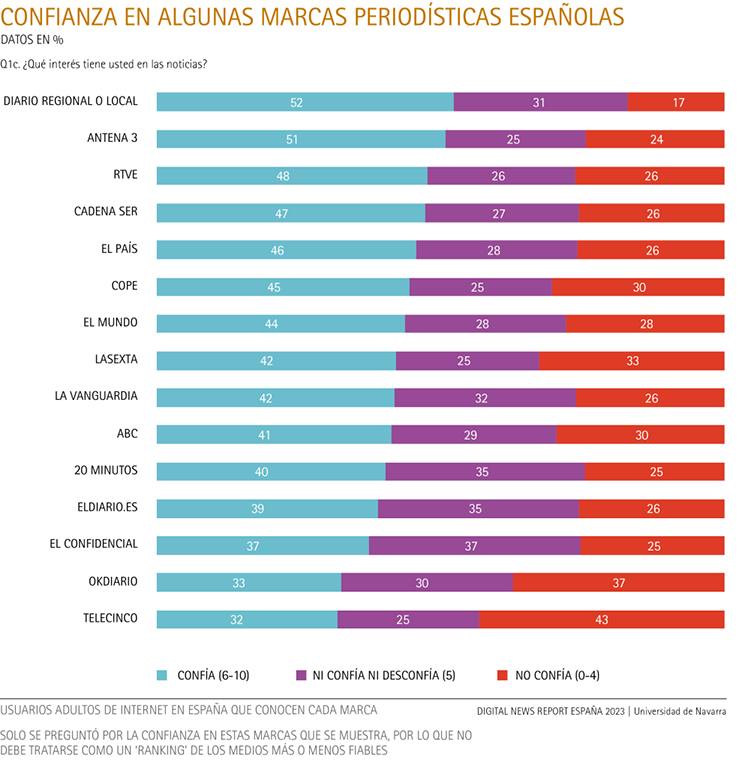
Therefore, the general trend in 2023 is a recovery in the confidence of Spaniards in the journalistic brands analyzed. However, this recovery differs according to brands. If the concept of net trust is applied and the percentage of trusting users is compared with the percentage of skeptics for each brand, it can be seen that the news companies with the greatest differences between the two groups are regional or local newspapers (+35.4 pp), Antena 3 (+26.5 pp) and RTVE and Cadena SER (+21.3 pp and 21.6 pp, respectively). In contrast, the brands with the smallest difference between users who trust and do not trust are OKDiario (-4.7 pp) and Telecinco (-11.3 pp). These differences imply that while some brands such as regional or local newspapers and Antena 3 have a significantly higher level of trust than distrust, others such as OKDiario and Telecinco have more users who do not trust them than those who do.
Disinterest and distrust: a fatal combination
Based on the Degree of trust/distrust in the news and the level of interest/disinterest in information, three years ago a typology of the Spanish population was established. Thus, in the first place we would have those respondents called ninis, because they declare to have neither interest nor confidence in the news. This group has been growing steadily B, both in Spain and in the countries analyzed as a whole, and is currently the most numerous (37% and 36%, respectively).
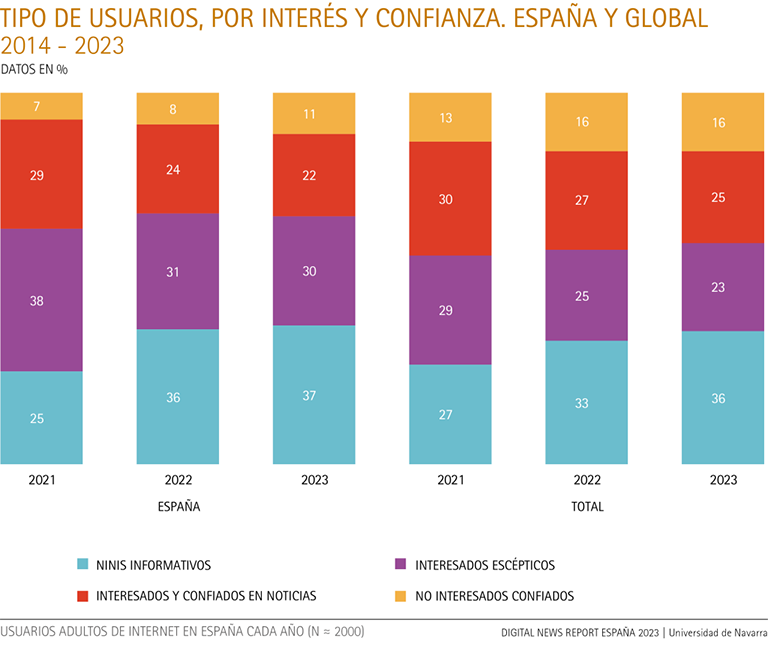
The second largest group of news consumers in Spain is made up of those interested in news but distrustful. In the last three years it has decreased from 38% to 30%. Globally, the figure has also fallen, from 29% in 2021 to 23% in 2023.
The group of those who say they are very interested and confident in the information has also been decreasing. Since 2021 sample a constant reduction in the percentages, from 29% to 22% in 2023. A similar trend has occurred in all the countries analyzed, although in Spain this group is slightly lower than the average for the countries studied.
Finally, the group of those not interested but confident in the news has experienced an increase and has risen from 7% in 2021 to 11% in 2023. Contrary to Spain, globally, this group has remained stable at 16% in 2022 and 2023, after an increase in 2021. In this case, Spain has an upward trend, although this group is considerably smaller in Spain than in the total number of countries.
At summary, the data show a general trend of decreasing trust in the news by both interested and uninterested people. This indicates a change in the perception of the news and greater caution on the part of the public. However, there is also an increase in the issue of people who are not interested in the news, but still trust it. These results reflect the complexity of attitudes and behaviors toward news and the need for greater understanding of the factors that influence public trust.
Continued concern about hoaxes on the internet
Spain remains one of the countries most concerned about hoaxes. It ranks 11th out of the 46 markets surveyed, with 64% of respondents concerned about what is real and fake on the Internet, compared to 11% who are not. The figure is up slightly on last year, following the trend across all countries. Within Europe, Spain is the third most concerned about this issue, behind only Portugal (71%) and the UK (64%).
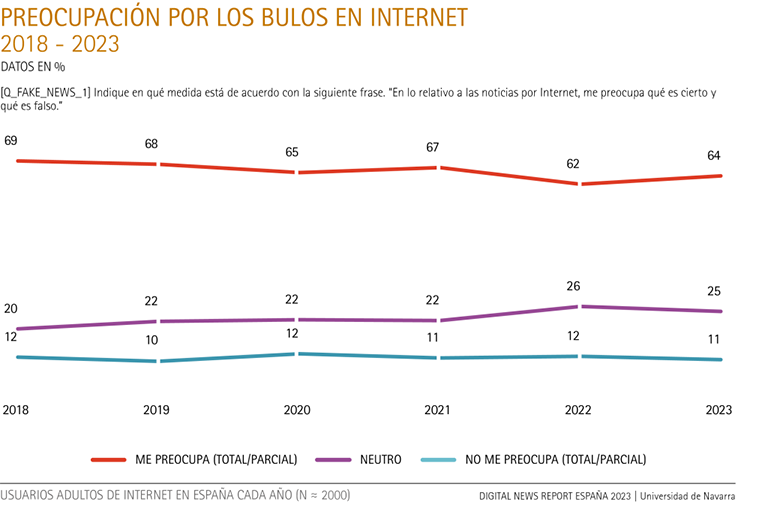
The following graph provides insight into the evolution of adult Internet users' concern toward hoaxes or misinformation circulating online over a six-year period, from 2018 to 2023.
As can be seen, the group of those totally or partially concerned about the dissemination of false content over the Internet has slightly decreased over the period analyzed, gradually going from 69% in 2018 to 64% in 2023. This decline could be interpreted as an indication that Internet users are becoming more critical and able to detect and avoid misinformation. However, the fact that two out of three respondents still express concern suggests that hoaxes remain a relevant problem.
The second group, characterized by a certain neutrality towards the hoax problem, sample an upward trend, albeit modest. This increase from 20% in 2018 to 25% in 2023 suggests that a growing issue of Internet users may be developing a more indifferent or resigned attitude towards disinformation. This could be due to a saturation of disinformation online, making it increasingly difficult for users to discern the truth.
Finally, the group of respondents who are not concerned about misinformation remains relatively constant over the six-year period, ranging from 10% to 12%. This constancy may indicate that a small but stable segment of the Internet user population does not feel particularly threatened or affected by information hoaxes. This group may have high confidence in their ability to discern disinformation, or they may not be as exposed to disinformation in the first place.
In general, these data reflect a reality in which information hoaxes have become a recognized part of the digital landscape in Spain. Although most Internet users still express some concern, there is a gradual trend towards neutrality, perhaps due to the omnipresence of disinformation, perhaps due to informational indifference.